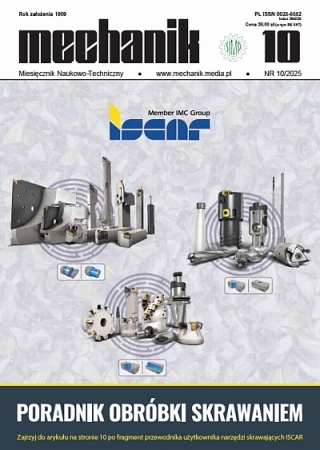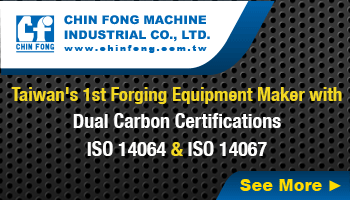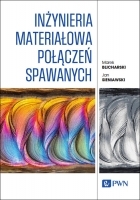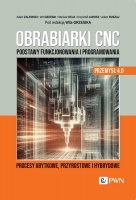Design, fabrication and characterization of ceramic-metal composites: an overview
Projektowanie, wytwarzanie i charakterystyka kompozytów metalowo-ceramicznych: przegląd
Mechanik nr 02/2015 - Artykuły z Międzynarodowej Konferencji Innovative Manufacturing Technology IMT 2014 zamieszczone na płycie CD
ABSTRACT: Composites are used for many different products in numerous industries applications. They satisfy the demand for new materials which combine dissimilar materials and represent properties which are not achievable by separate material. Among of them are ceramic matrix composites, especially with metal phase. Different systems have been developing. During the last years the composites with Al2O3, ZrO2 ceramic matrix and metals as Ni, Mo, Cu, W, Co have been intensively studied.
Metallic particles embedded into ceramic matrix improved mechanical properties such as the toughness, the hardness and the wear resistance. Moreover, other properties as magnetic or electrical of ceramic-metal composites can be significantly changed. Because of that, ceramic- metal composites are considered as structural and functional materials.
The final properties of ceramic-metal composites depend on their microstructure, which should be optimize by the design of metal size and distribution into ceramic matrix and selection of the fabrication method.
This paper attempts to review the microstructures of ceramic-metal composites based on own experimental results. The following issues will be discussed: design the metal particles distribution into ceramic matrix, opportunities of processing in creating microstructures and fabrication of composites with complex shape and high dimensions, interactions in ceramic/metal interfaces, toughening mechanisms and properties of composites.
KEYWORDS: ceramic-metal composite, ceramic matrix composite, microstucture, fabrication of composites, functional materials, metal particles distribution, properties of composites.
STRESZCZENIE: Z kompozytów wykonywane są elementy wykorzystywane do różnych zastosowań przemysłowych. Wynika to z możliwości uzyskania w nich właściwości nie spełnianych przez pojedynczy materiał. Wśród kompozytów o osnowie ceramicznej intensywne prace prowadzone są nad kompozytami z wprowadzoną faza metaliczną. Do częściej badanych układów zalicza się ceramikę Al2O3 oraz ZrO2 w połączeniu z metalami jak Ni, Mo, Cu, W czy Co.
Wprowadzenie cząstek metalu do osnowy ceramicznej zapewnia zwiększenie odporności na kruche pękanie przy zachowaniu wysokiej twardości. Jednocześnie inne właściwości, jak elektryczne czy magnetyczne, mogą być modyfikowane. Dlatego też coraz częściej kompozyty ceramika-metal są postrzegane jako materiały o możliwości zastosowania jako konstrukcyjne i funkcjonalne. Właściwości kompozytów ceramika-metal zależą od ich mikrostruktury, która powinna być optymalizowana poprzez proces projektowania rozmiaru i rozmieszczenia cząstek metalu w osnowie ceramicznej oraz dobór metody wytwarzania.
W artykule przedstawiono przegląd mikrostruktury kompozytów ceramika-metal bazując na własnych pracach w tym zakresie. Analizowano sposób rozmieszczenia cząstek metalu w osnowie ceramicznej, zalety metod wytwarzania pozwalające na wykonywaniu złożonych kształtów próbek kompozytowych oraz o dużych rozmiarach. Omówiono oddziaływania na granicy międzyfazowej ceramika/metal oraz mechanizmy odpowiedzialne za wzrost odporności na kruche pękanie, jak i właściwości kompozytów.
SŁOWA KLUCZOWE: kompozyt o osnowie ceramicznej, kompozyt metalowo-ceramiczny, mikrostruktura, materiał funkcjonalny, rozmieszczenie cząstek metalu, właściwości kompozytów.
BIBLIOGRAFIA / BIBLIOGRAPHY:
- FLINN B.D., RUHLE M., EVANS A.G., Toughening in composites of Al2O3 reinforced with Al, Acta Metall Mater , 1989, 37(11), 3001–3006.
- NAWA M., SEKINO T., NIIHARAK., Fabrication and mechanical behaviour of Al2O3/Mo nanocomposites, J Mater Sci 1994,29, 3183–3192.
- RODRIGUEZ-SUAREZ T., BARTOLOME J.F. MOYA J.S. Mechanical and tribological properties of ceramic/metal composites: A review of phenomena spanning from the nanometer to the micrometer length scale, Journal of the European Ceramic Society 2012, 32, 3887–3898.
- MOYA J.s., LOPEZ-ESTEBAN S., PECHARROMA’N C., The challenge of ceramic/metal microcomposites and nanocomposites, Progress in Materials Science 2007, 52, 1017–1090.
- TUAN W.H., WU H.H., YANG T.J., The preparation of Al2O3/Ni composites by a powder coating technique, Journal of Materials Science 1995, 30, 855-859.
- YEOMANS J.A, Ductile particle ceramic-matrix composites-scientific curiosities or engineering materials?, Journal Eur. Ceram. Soc.2008, 28, 1543-1550.
- ESTEBAN L., BARTOLOME J.F., MOYA J.S., TANIMATO T., Mechanical performance of 3Y–TZP/Ni composites: tensile, bending and uniaxial fatigue tests, J Mater Res 2002;17(7), 1592–600.
- KONOPKA K., SZAFRAN M., Fabrication of Al2O3-Al composites by infiltration method and their characteristic, Journal of Materials Processing and Technology2006, 175, 266-270.
- OMATETE O.O.,JANNEY M.A., NUNN S.D., Gelcasting: From laboratory development toward industrial production, J. Eur. Ceram. Soc. 1997, 17, 407-413.
- MIAZGA A., KONOPKA K., GIZOWSKA M., SZAFRAN M., Alumina matrix ceramic-nickel composites formed by gelcasting method, Composites Theory and Practice, 2012, 12, 2, 138-141.
- OZIĘBŁO A., KONOPKA K., BOBRYK E., SZAFRAN M., KURZYDŁOWSKI K.J., Al2O3-Fe Functionally Graded Materials Fabricated Under Magnetic Field, Solid State Phenomena, 2005, 101-102, 143-146.
- OZIĘBŁO A., WEJRZANOWSKI T., KONOPKA K., SZAFRAN M., KURZYDŁOWSKI K.J., Microstructure of Al2O3-Fe FGM obtained by modified slip-casting method, 2005, Materials Science Forum 2005, 492-493, 665-672.
- SZAFRAN M., KONOPKA K., BOBRYK E., KURZYDŁOWSKI K.J., Ceramic matrix composites with gradient concentration of metal particles, Journal of the European Ceramic Society 2007, 27, 651-654.
- KONOPKA K., LITYŃSKA-DOBRZYŃSKA L., DUTKIEWICZ J., SEM and TEM characterization of NiAl2O4 spinel phase in Al2O3 matrix Ni composite, Solid State Phenomena 2012, 186, 222-225.
- KONOPKA K., LITYŃSKA-DOBRZYŃSKA L., DUTKIEWICZ J., SEM and TEM studies of NiAl2O4 spinel phase distribution in alumina matrix, Archives of Metallurgy and Materials2013, 58, 501-504.
- KONOPKA, K. MIAZGA A., WŁASZCZUK J., Fracture toughness of Al2O3-Ni composites with nickel aluminate spinel phase NiAl2O4, Kompozyty 2011, 11, 3, 197-201.
- KONOPKA K. Nickel aluminate spinel (NiAl2O4) in Al2O3-Ni composites, Inżynieria Materiałowa2010, 3, 175, 457-459.
- HANNINK, R.H.J. KELLY P.M., MUDDLE B.C., Transformation toughening in zirconia-containing ceramics, Journal of the American Ceramic Society 200, 83,3, 461-487.
- KUN-LIN L., CHIEN-CHENG L., Reaction between titanium and zirconia powders during sintering at 1500°C,, Journal of the American Ceramic Society 2007,90, 7, 2220-2225.
- TENG L., LI W., WANG F., Effect of Ti content on the martensitic transformation in zirconia for Ti-ZrO2 composites, Journal of Alloys and Compounds 2001, 319,228-232.


























